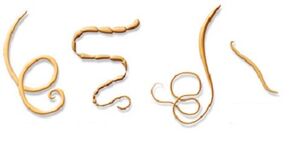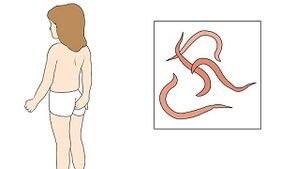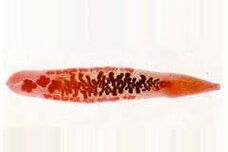Different types of parasites can be present in the human body for a very long time, causing very specific damage to health.
A significant number of people suffer from serious illnesses caused by parasites. At the same time, many have no idea about the presence of parasites in the intestines and other organs.
Each parasite species known to science has its own individual characteristics that an adult should know about.
Risk of infection

At present, science knows more than 200 species of parasites, for which the human body is a habitat.
The ways and means of penetration of pests to the most favorable place of stay have been studied in detail. We can say that each type of parasite has its own "specialization".
Many helminths live in the gastrointestinal tract. There are also those that parasitize the liver, lungs and even the brain.
Almost all people are prone to parasitic attacks. It is just as likely to be an adult or a nursing baby.
A great danger is the presence of parasites in children. First of all, this is reflected in the state of health. Babies often get sick for no apparent reason.
There is a delay in physical and mental development. It is not so easy to identify the cause of the disease, although it is often "found" in plain sight.
It is enough to carry out certain studies, to identify the type of parasite and to prescribe a treatment.
A significant number of adults are at risk because their professional activities are associated with the processing of raw materials contaminated with helminths.
Some species of pests are very resistant to environmental influences and can be destroyed with great difficulty.
Pest varieties
The appearance of parasites in the human body is always accompanied by certain signs.
The peculiarity of this situation is that the symptoms are often very weak and it is difficult to detect the presence of pests without special studies.

The following types of helminths parasitize the body:
- round;
- tape;
- moat.
This classification is compiled taking into account external characteristics, whereas, regardless of the species, parasites have many characteristics in common.
Different shaped hooks and suction cups are designed to make it easier for parasites to fix their position in a certain place.
The life cycle of many parasites consists of several stages. Additionally, a species like a tapeworm has two "owners" - a human and a pet.
Closed-loop migration gives these parasites the ability to exist and reproduce. In the process of movement, the parasite enters the human body and feeds on it.
This function is inherent in all microorganisms that live in the intestines or other organs. Only useful species are included in creative activity, and parasites are included in destructive activity.
Given these circumstances, humans must support the beneficial and suppress the parasites.
Roundworms
Roundworms include the roundworm. It is a parasite of orange color and without suckers.
The shape of the spindle allows it to migrate through different organs and penetrate the smallest openings and folds. This type of parasite is able to invade the lungs or the pancreas.
The eggs laid by the roundworm are protected by a strong shell that can resist the destructive effects of hydrochloric acid in the stomach. Most often, people get infected by eating unwashed vegetables and fruits.
Pinworm enters the human body in exactly the same way. In appearance, it is a thin striped worm of pale gray color, up to 10 mm in length. Already in the larval stage, the parasite begins to harm humans.

As it develops into a mature specimen, the larva secretes toxic enzymes that irritate the intestinal lining.
An adult pinworm is able to penetrate the deep layers of the small intestine and penetrate it right through. In such situations, a serious disease called peritonitis develops.
Another round parasite that parasitizes the large intestine is the whipworm.
On ingestion, the following symptoms appear:
- headache and dizziness;
- persistent abdominal pain;
- sleep disorder.
Vlasoglav gets its name from its external characteristics - the worm is very thin and reaches a length of 50 mm. The parasite is the causative agent of trichocephalosis.
It never leaves the body - the worm can only be destroyed after which the parasite comes out with the feces.
Tapeworms
The appearance of parasites in humans follows similar scenarios. Tapeworms from pork and cattle in the form of tapeworms enter the body when consuming meat, respectively pork and beef contaminated by the Finns.
In appearance, these Finns, or larvae, are white bubbles and look like millet porridge.
On reaching the intestines, the larvae retreat and begin to develop into a full-fledged parasite. Development is asymptomatic in most cases.
After about three months, the tapeworm is already able to reproduce. This type of pest reaches a length of ten meters or more.
The presence of tapeworm in the body causes severe disease of tapeworm. A more serious threat to human health is the band-type parasite Echinococcus.

For this parasite, the human body is an intermediate haven. The main owners are animals - dogs and cats. People get infected through contact with their beloved animals through food - through the mouth.
Upon reaching the intestines, the eggs begin to develop into larvae, which have six hooks for attachment.
Along with the bloodstream, they are transported to various organs and are most often attached to the liver and lungs.
As it grows, the echinococcus begins to destroy surrounding tissue. Sometimes quite large parasites are mistaken for a tumor.
Alveococcus is another representative of the band parasite in the human body. After entering the intestine, the larvae develop intensely and enter the walls of the small intestine and are carried by the bloodstream through various organs and systems.
Like echinococcus, the parasite is attached to the liver and begins its destructive activity.
Alveococcus takes the form of a multi-chambered bladder called a larvocyst. These larvocysts are capable of invading liver tissue and becoming cancerous metastases.
The blood supply to the liver tissue is interrupted, necrosis begins, which poses a serious danger to human health and even life.
To Fluke
The list of tapeworms contains a separate species of parasite called a fluke.
The following species are particularly dangerous moats:
- fluke cat;
- fasciole;
- schistosome.

Liver disease is more common among human diseases than other organic diseases. The moats get their name from their anatomical structure.
There are several suction cups on the body of the parasite, with the help of which the pest stands in a certain place and penetrates deep into living tissue.
The feline fluke is most commonly found in the gallbladder and pancreatic ducts.
Fluke enters the human body with fish that have not been sufficiently salted or boiled.
In people affected by this pest, the temperature rises sharply, an unreasonable cough appears, and rashes appear on the body. If you do not take emergency measures, the person can die.
Fasciola is absorbed into the body by drinking unboiled water. With the connivance of the patient, it causes chronic jaundice.
Schistosomiasis, which is caused by a rare parasite, has become more common in recent years.
This is due to the fact that a large number of people have started to visit tropical countries where this pest is widespread.
Preventive measures
Medical practice shows that parasites take root much more often in the intestines than in other organs.
Pests of various species are able to adapt to exist in the liver, lungs, heart, brain and even in the eyes - only this list gives a sufficient idea of the danger posed by parasites to healthhuman and life.

Different types of parasites can enter the body both individually and in combination, which increases the severity of the injury.
In order to prevent parasites of any kind in your body, it is enough to follow the basic rules of hygiene and sanitary requirements for food.
Young children should be kept under constant supervision, especially in summer when going to the countryside or to the sea.
Today it is not necessary to eat raw meat or fish, including sliced meat. This atavism must be left forever in the past, so as not to expose your body to undue risks.
















































